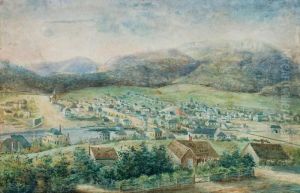George Augustus Robinson Paintings
George Augustus Robinson was born on March 22, 1791, in London, England. He is not primarily remembered as an artist in the conventional sense but rather as a colonial administrator, builder, and a controversial figure in the history of Australia, especially for his role in the dealings with the Indigenous populations of Tasmania during the early 19th century. Robinson's legacy is complex, involving aspects of both humanitarian efforts and the darker realities of colonial expansion and its impact on Indigenous communities.
Robinson initially moved to Australia in 1824, where he began his work in Van Diemen's Land, now known as Tasmania, as a builder and untrained missionary. His most notable role came about in the 1830s when he was appointed as the Chief Protector of Aborigines by the colonial government. Tasked with resolving the violent conflicts between the European settlers and the Indigenous Tasmanian populations, Robinson embarked on what he called the 'Friendly Mission'. Throughout this mission, he traveled extensively across the island, negotiating with the Aboriginal communities to move to Flinders Island, promising them protection and a way of life free from the escalating violence of the colonial frontier.
Despite his intentions and the peaceful approach of his mission, the outcomes of his efforts are viewed critically by historians and the public alike. The relocation resulted in significant suffering for the Indigenous Tasmanians, who faced diseases, displacement, and the erosion of their cultural practices and social structures. The Flinders Island settlement did not live up to the promises made by Robinson, and it became a symbol of the failure of colonial policies to protect Indigenous interests and lives.
After his work in Tasmania, Robinson went on to serve in similar capacities in Victoria, continuing his work with Indigenous communities. He returned to England in 1855, where he remained until his death on October 18, 1866. Throughout his life, George Augustus Robinson kept detailed journals of his interactions and observations, which provide valuable, albeit contentious, insights into the early contact period between European colonizers and Indigenous Australians. His legacy is a subject of ongoing debate, reflecting the complexities of colonial history and its lasting impacts on Indigenous peoples.
